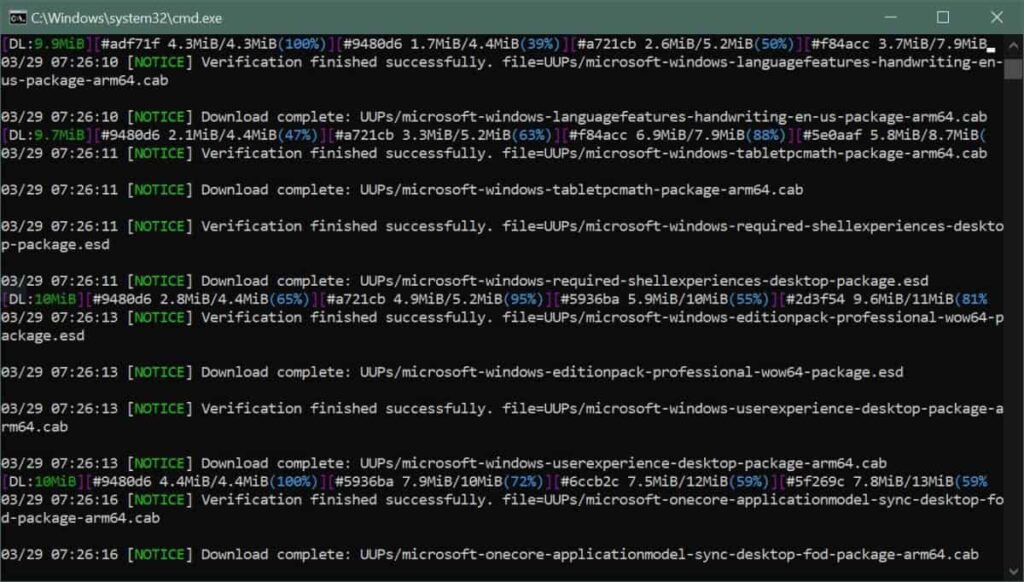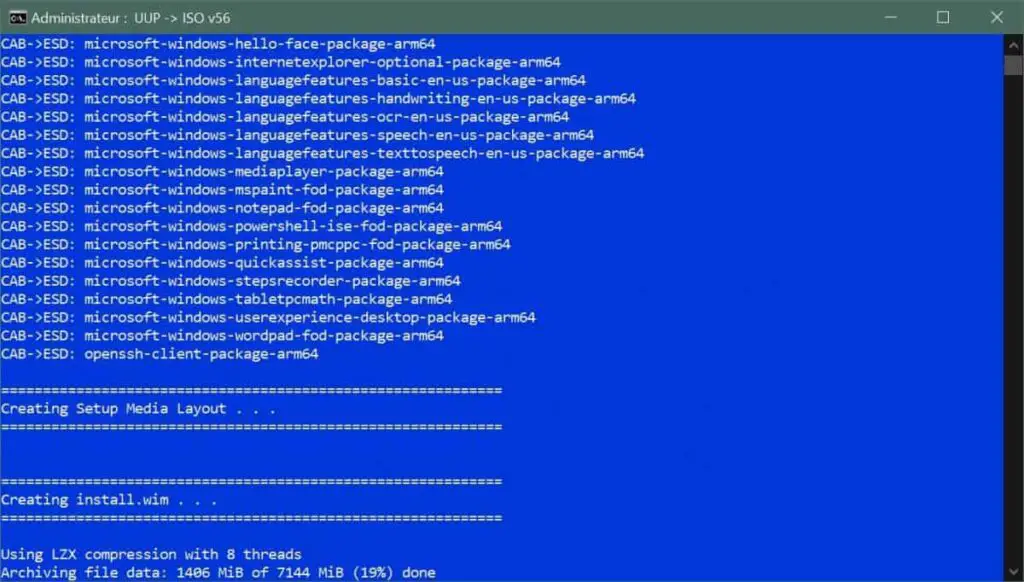Время на прочтение4 мин
Количество просмотров90K

В середине июля 2020 года эксперты портала Tom’s Hardware опубликовали инструкцию по установке Windows 10 на Raspberry Pi 4. Вдобавок они проверили, как работают некоторые сторонние программы (GIMP Photo Editor, Arduino IDE и Python 3.8) в этой связке микрокомпьютера на ARM и последней версии Windows.
Вопрос «зачем» тут не особо уместен, так как экспериментаторам был важен сам факт того, что это можно сделать и все будет работать. Да, медленно и с тормозами и проблемами, но будет.
Официально, единственная операционная система Microsoft для Raspberry Pi — это устаревшая на текущий момент версия Windows 10 IoT Core, которая, например, позволяет выполнять код Visual Studio на микрокомпьютере, но там даже нет графического интерфейса. Тем не менее, разработчики (например, проект «Windows on Raspberry Pi» в Discord) своими силами сделали необходимы программы и нашли способ по установке и запуску полноценной версии Windows 10 на Raspberry Pi 4.
Эксперты портала Tom’s Hardware дополнительно уведомили, что они не могут ручаться за безопасность или законность любых пользовательских файлов, созданных сообществом «Windows on Raspberry Pi», поэтому все действия далее они делали на свой страх и риск.
В 2019 году эксперты портала Tom’s Hardware уже попытались установить Windows 10 на Raspberry Pi 3, но тогда этот трудный процесс у них закончился по большей части проблемами, ошибками и тормозами после установки.
В настоящее время даже после всех стараний команды проекта «Windows on Raspberry», после установки Windows 10 на Raspberry Pi 4 не работают встроенные в микрокомпьютер порт Ethernet, модули Wi-Fi, Bluetooth и GPIO, аудио через HDMI также недоступно. Для сетевого подключения нужно использовать Wi-Fi USB-адаптер, а для вывода звука Bluetooth через USB-адаптер.
Для установки Windows 10 на Raspberry Pi 4 понадобятся:
- последняя версия Raspberry Pi 4 с 4GB или 8GB ОЗУ;
- карта памяти microSD на 16 GB или больше;
- ПК с Windows 10 и доступом в сеть интернет для создания нужной загрузочной сборки;
- адаптер USB to Ethernet или WiFi dongle;
- Bluetooth dongle (если нужен Bluetooth).
Инструкция по установке Windows 10 на Raspberry Pi 4:
- нужно скачать и распаковать на ПК последнюю версию инструмента WoR 2.0.0 alpha 3, там будет архив на 4.7G;
- зайти на Windows on Raspberry Pi Discord server в разделе Downloads channel скачать последнюю стабильную версию Windows on ARM (0.2.1), ссылка на этот файл PublicFlukeByte.iso;
- запустить WoR Alpha tool и выбрать язык установки;
- вставить в ПК карту памяти и выбрать ее в WoR Alpha tool в разделе «Select device», там же выбрать режим «Raspberry Pi 4 experimental mode»;
- далее в разделе «Select image» указать место расположения на ПК ранее скаченного файла PublicFlukeByte.iso;
- далее в разделе «Select drivers» выбрать опцию «Use the latest package available on the server.»;
- далее в разделе «UEFI firmware» выбрать опцию «Use the latest firmware available on the server.»;
- потом нужно проверить конфигурацию загрузочной сборки и начат ее записать на карту памяти, причем запись может продолжаться более двух часов, в зависимости от параметров карты памяти;
- скачать и распаковать на ПК патч для Raspberry Pi 4 по активации USB-портов и 3 ГБ ОЗУ в Windows 10, скопировать файл winpatch.exe в корень диска C: на ПК;
- пропатчить сборку на карте памяти: в командной строке на ПК выполнить
«winpatch X:\Windows\System32\drivers\USBXHCI.SYS 910063E8370000EA 910063E8360000EA 3700010AD5033F9F 3600010AD5033F9F», где Х — буква диска с картой памяти; - рекомендуется также «разогнать» в настройках Raspberry Pi, но тогда лучше заранее обеспокоиться установкой на микрокомпьютер системы охлаждения, для этого необходимо в файле config.txt на загрузочном карте памяти выставить параметры: «over_voltage=6» и «arm_freq=2000»;
- теперь можно извлечь загрузочную карту памяти из ПК, вставить ее в Raspberry Pi 4 и начать стандартную установку ОС Windows 10;
- после окончания процесса установки Windows 10 на Raspberry Pi 4 необходимо активировать в ОС возможность полноценно использовать 3 ГБ ОЗУ, для этого нужно под администратором в командной строке запустить: «bcdedit /deletevalue {default} truncatememory», далее необходимо перезагрузить микрокомпьютер;
- далее можно подключить сетевые USB-адаптеры, настроить их и скачивать и устанавливать из интернета необходимые для работы приложения, включая браузеры и другое ПО.
Эксперты портала Tom’s Hardware установили на Raspberry Pi 4 с Windows 10 браузер Microsoft Edge, программы GIMP Photo Editor, Arduino IDE и Python 3.8 с оболочкой Python REPL. Все программы запускались и работали нормально. По скорости работы с этой ОС микрокомпьютер оказался на уровне Intel Celeron или Atom начального уровня. Время загрузки ОС Windows 10 составило 2 минуты 12 секунд. Просмотр видео в YouTube возможен, но со средними настройками разрешения роликов. Из проблем — на эту сборку не удалось установить редактор кода Visual Studio Code. Также не работал модуль Python под названием GPIO Zero, который используется для взаимодействия с GPIO Raspberry Pi. Возможно, что в будущем эти моменты будут доработаны разработчиками проекта «Windows on Raspberry Pi».
Ранее в феврале 2020 года Raspberry Pi Foundation выпустил обновленную версию (v1.2) Raspberry Pi 4, в которой было исправлено несколько проблем, включая совместимость с различными USB-C кабелями. Тогда микрокомпьютер не распознавал некоторые кабели как источник питания из-за проблем со схемой питания.
В конце мая 2020 года в продажу поступила 8-гигабайтная модель Raspberry Pi 4. Она доступна по цене в $75. Вдобавок создатели портативного ПК сняли с продажи версию с 1 ГБ оперативной памяти, теперь за $35 можно приобрести Raspberry Pi 4 с 2 ГБ ОЗУ.
См. также:
- «Raspberry Pi Foundation захостила свой сайт на Raspberry Pi 4. Теперь этот хостинг доступен всем»
- «Протокол UASP ускоряет передачу файлов на Raspberry Pi 4 в полтора раза»
- «Любитель подключил PCIe к Raspberry Pi без контроллера USB»
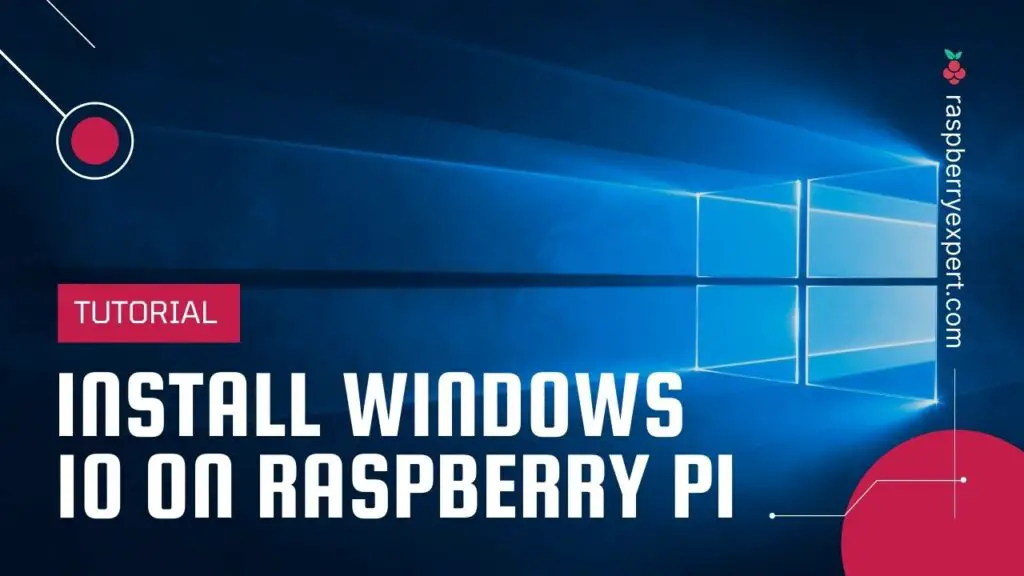
The Raspberry Pi is usually associated with Linux operating systems like Raspberry Pi OS (formerly known as Raspbian), Ubuntu, etc. But what about running Windows 10 on your Raspberry Pi? Well, it would be great for sure. However, Windows 10 is still not officially supported for Raspberry Pi. Microsoft’s only OS for Pi is the old Windows 10 IoT Core that just lets you execute Visual Studio codes but cannot work as a standalone OS with its GUI.
Though it is so, it didn’t stop some passionate developers to find a way to run a full desktop version of Windows 10 on Raspberry Pi. They have made it possible with the WoR project. With that, they developed a tool to flash an ARM image of Windows 10 on an SD Card (or an SDD), that can boot on a Raspberry Pi.
In this guide, I’ll walk you through the exact steps to install Raspberry Pi Windows 10.
Contents
- Requirements
- Steps to Install Windows 10 on Raspberry Pi 4/3/2
- Step 1: Download the Required Files
- Step 2: Update Raspberry Pi Firmware
- Step 3: Build Windows 10 ISO File on your PC
- Step 4: Flash the ISO File with WoR Tool
- The First Boot
- Overclock the Raspberry Pi
- How Does Raspberry Pi Windows 10 Perform?
- Now it’s your turn..
Requirements
- Raspberry Pi 4/3/2
- MicroSD Card (Faster is better, so a class A2 card is recommended)
- Ethernet Cable or Wi-Fi dongle
- Keyboard, Mouse, and Monitor
Step 1: Download the Required Files
In order to get started with the installation, you have 2 things to download.
1. The WoR Tool [https://www.worproject.ml/downloads]
When you download this you will get a zip file with everything inside it. Keep it for now. We’ll use it later.
2. UUP file for Windows 10 ARM
For downloading a UUP file you can use any one of the following websites. Each of them works a bit differently. On these websites, you only have to choose a Windows version, build number, language, and edition like Pro, Home, Ultimate, etc.
- https://uupdump.net/ (for Linux or Mac PC)
Download the file from this website only if your computer is not running on Windows OS. While on the website, I recommend selecting only one edition to keep the file size smaller and make the installation faster. Only check the required edition and leave others unchecked. Now choose the Download and convert to ISO option.
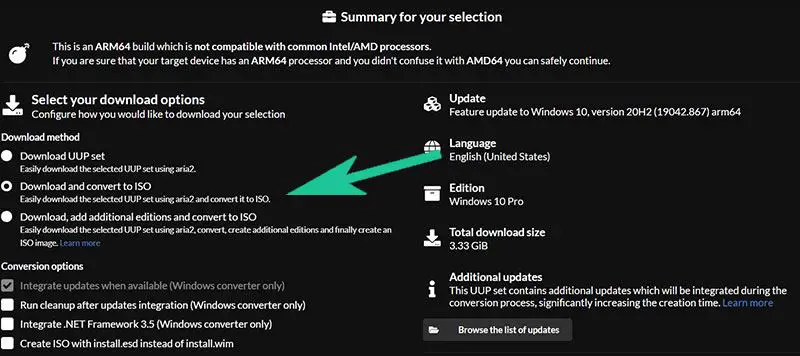
- https://uup.rg-adguard.net/ (for Windows PC only)
This site has got a much more intuitive interface where you can easily download the file. Use the drop-down arrows to choose the required version number, edition, build number, etc. Then click on the Download ISO compiler in One click! option in the download type. Download the cmd file by clicking on the link appearing on the right side. This will look something like this:
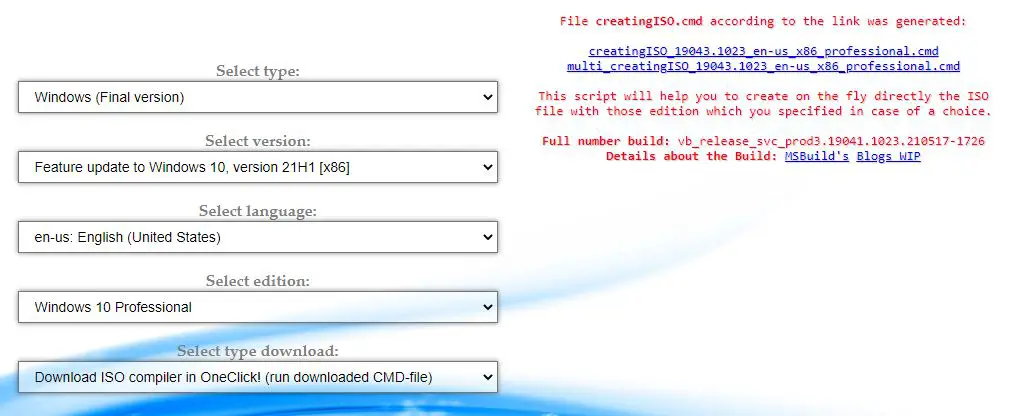
Step 2: Update Raspberry Pi Firmware
As usual, before doing something big, we have to update the firmware of our Raspberry Pi. To do the same, open a terminal and type the following command.
sudo apt update
sudo apt full-upgradeOnce done with that, stop your device and you don’t need the Raspberry Pi OS (Raspbian) anymore.
Step 3: Build Windows 10 ISO File on your PC
The next step is to build the Windows 10 ISO image file using the cmd file that we’ve download in step 1. If you downloaded the file from the second website you will get the direct cmd file whereas if you have downloaded it from the first website (uupdump.net) then you need to extract the zip file to see a file named “uudp_download_windows.cmd“.
- Double click on the cmd file and you will see a terminal window. Press 0 when asked. It will immediately start to download some files for the process. This will be of a few gigabytes and take a lot of time if your internet connection is slow.
- Once the downloads are complete it will automatically start to build the ISO image file.
- This also will take some time. If you encounter any stuck somewhere in the process just press the Enter.
Step 4: Flash the ISO File with WoR Tool
Now it’s time to flash the ISO file that we build just now. Here comes the use of the WoR tool. It is a simple and easy-to-use flashing tool. To flash the ISO, follow the below steps.
- Firstly, extract the WoR_Release_….zip archive to a new folder on your computer.
- Find the wor.exe file and double-click on it.
- Select your preferred language from the drop-down list.
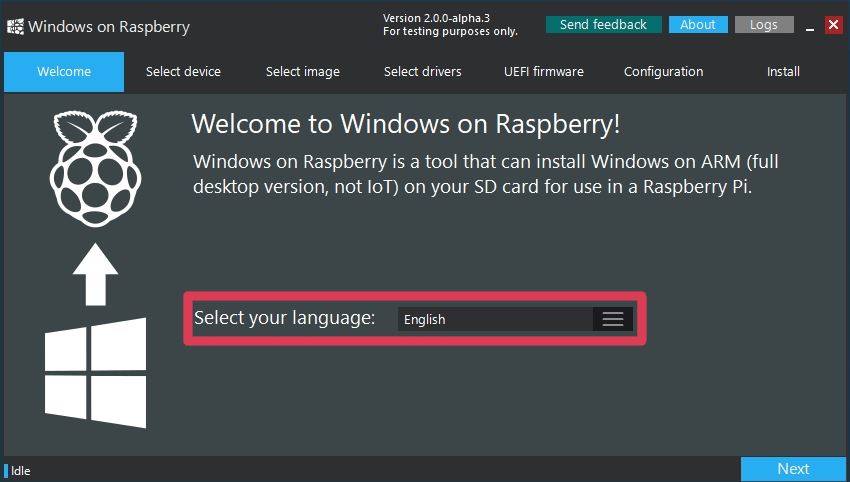
- Choose the target drive (your SD Card or SSD drive) and the model of your Raspberry Pi board.
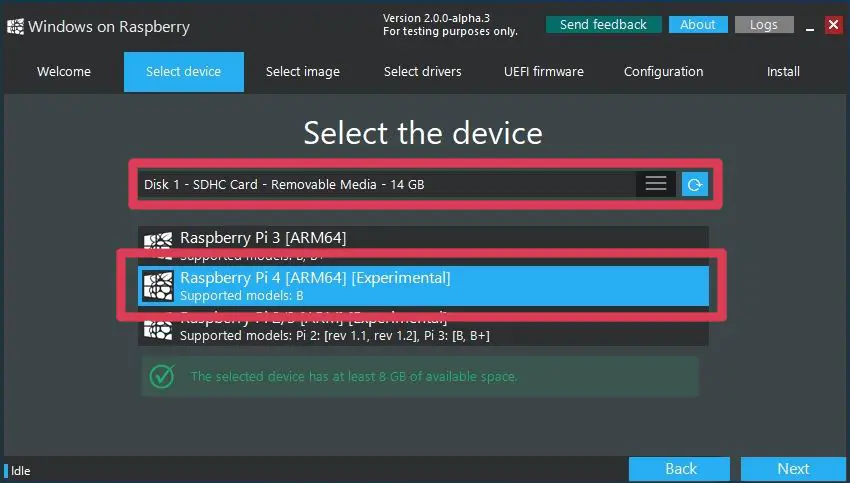
- Once all those selected, now navigate and choose the ISO file that we’ve built.
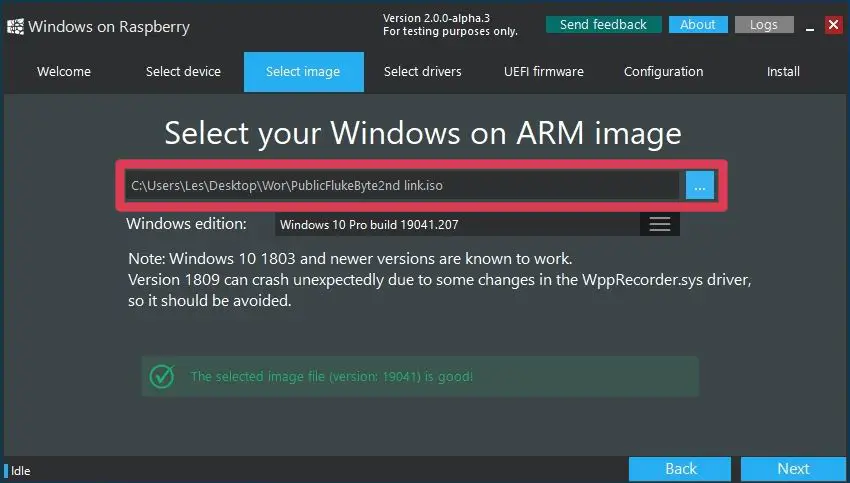
- The next step is to select the driver package from the server. Simply select the latest package.
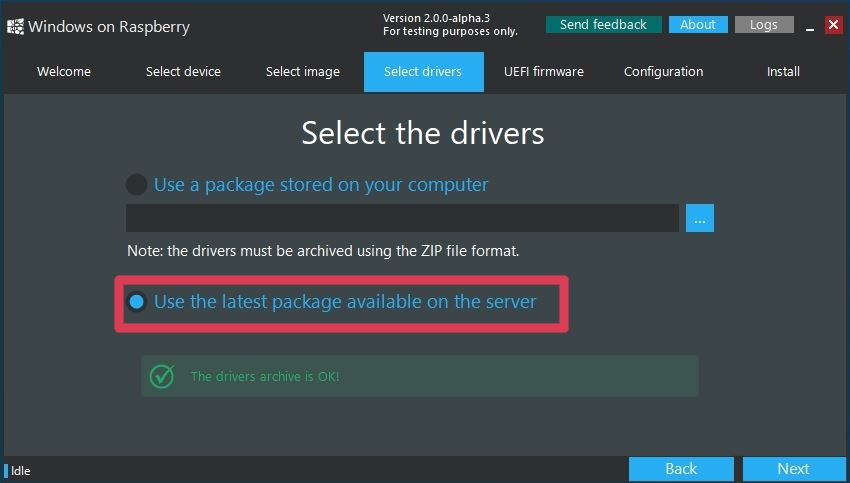
- Then select the UEFI firmware to flash. Here also select the latest version available.
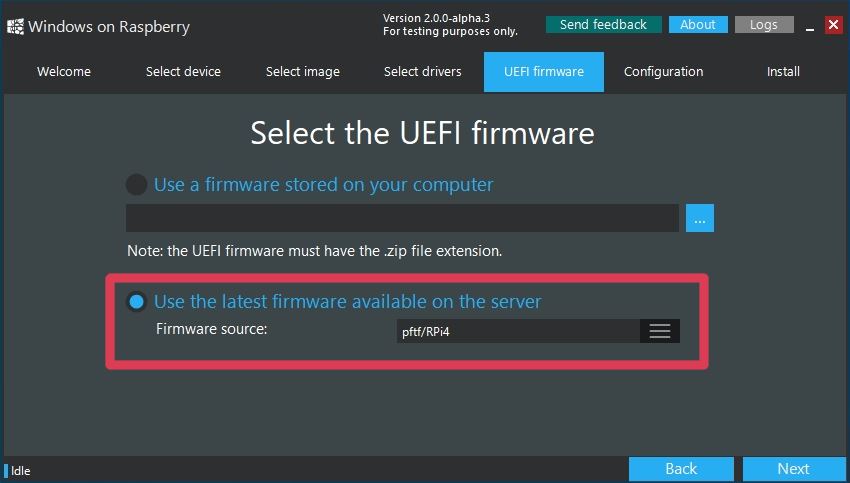
- Check the configuration and click Next.
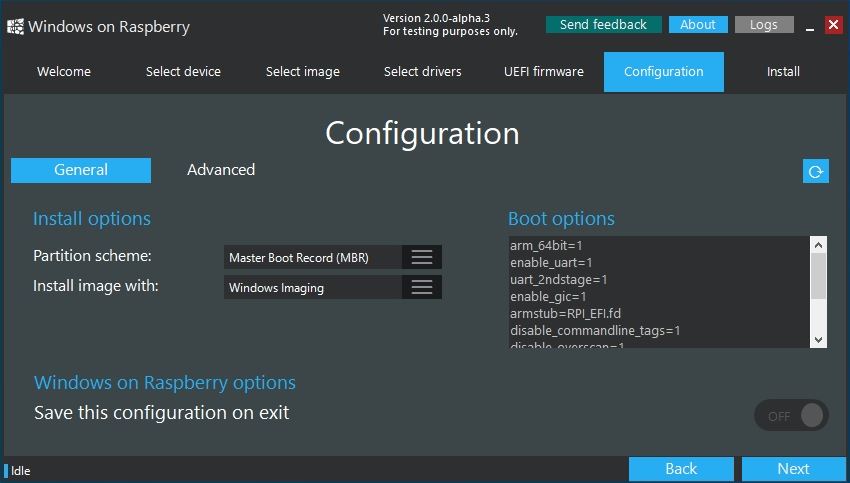
- So you have selected all the things to get started with the install. Just double-check everything and click Install.
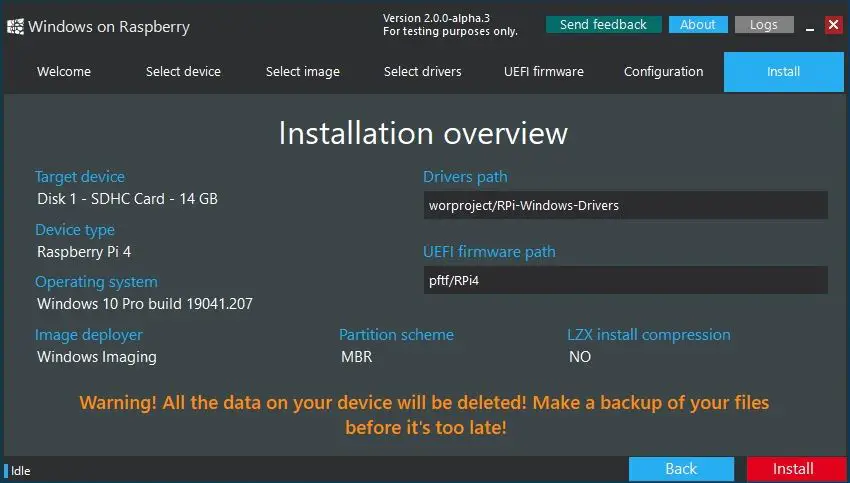
The installation may take as long as 1.5 to 2 hours, depending on the write speed of your SD Card. This is why I recommend getting an A1 or A2 class SD Card or else an SSD drive to get the job done much faster. On an SSD drive, it may take only about 15 minutes or so.
The First Boot
And now once the Raspberry Pi Windows 10 installation is completed and your device is ready, you can directly plug it (if you have an SSD) into the Pi or insert it if you have an SD card. Then boot it up.
Since it is the first boot, it will take some time to completely initialize and configure things according to your device and boot up. However, from the second boot onwards everything will be fine and will work as normal. If you are a beginner and don’t know how to set up a remote desktop on your Raspberry Pi, just relax – I’ve got that covered for you. Head over to this link: How to Setup Raspberry Pi Remote Desktop on Windows/ Linux/ Mac (5 Methods)
As usual with a typical Windows installation, you will need to configure some things manually: for example Cortana and the privacy policies that Windows normally tries to disable for you.
Once done with that, you will enter into a full-fledged Windows 10 on your cute little Raspberry Pi.
Overclock the Raspberry Pi
Now that you have successfully completed the Raspberry Pi Windows 10 installation, and thinking to boost the performance?
Well. That’s indeed a right thought. Overclocking a Raspberry Pi will help you get the most out of your SBC and take your projects to the next level. For this purpose, I have written a comprehensive article on how to overclock Raspberry Pi board. You can click on the link and refer to the article.
How Does Raspberry Pi Windows 10 Perform?
In my testing, the overall performance is pretty much decent and it’s smoothly usable. However, it has the following limitations.
- Resource limits will be reached quickly with some usage.
- CPU usage is almost 100% while streaming YouTube in Google Chrome.
- Bluetooth support is also limited as the RTS/CTS lines are not exposed.
- Problems with HDMI audio out.
Though it is having some limitations, you will get a nice Windows 10 experience on your tiny computer. You can get partially get rid of the resource exhausting problem by providing an A2 class 32/64 GB SD card or a super-fast SSD drive.
Now it’s your turn..
It’s now your turn to try the Raspberry Pi Windows 10 installation and share your experience. I’ve tried to make this tutorial as simple as possible and still if you have any queries just drop them in the comment section below.
Found an issue with this article? Report it here, so that I can resolve it.
If you click our links and make a purchase, we may earn an affiliate commission.
Learn more
Windows and Raspberry Pi is a long story. After having only the IoT version available to play with, Microsoft is now working on an ARM version of the full Windows 10 system. Windows still doesn’t officially support the Raspberry Pi, but with a few tools and a good tutorial, you can find a way to make it work on your device. That’s the goal of this post.
The WoR project (Windows on Raspberry Pi) develops a tool to flash an ARM image of Windows 10 to an SD card (or SSD drive), that can boot on Raspberry Pi. So, it’s now possible to use Windows 10 full version on Raspberry Pi.
In this step-by-step tutorial, I’ll guide you through the installation process. The theory might be simple, but the entire procedure is pretty long.
By the way, there are already plenty of articles on this topic (mostly news type in fact), but when I tried it myself, I struggled to understand the whole process and put it into practice. That’s why I’m writing it here for you.
Note: Windows 11 is now available, the process is even simpler than the one explained in this tutorial. I highly recommend reading this other article if you are interested.
Want the best experience? Become a premium member for ad-free browsing, access exclusive content, and ask questions in our private forums. Your membership helps support the site!
The theory: Windows 10 on ARM
If you are new to this, there is a lot to unpack here before flashing your SD card. We’ll start by looking at the big picture and see why the installation process is not the same as usual.
Microsoft and ARM
All Raspberry Pi models are running on the ARM architecture, so there’s nothing new there. Microsoft had minor projects for us (Windows 10 IoT) but never released a full Windows 10 on this platform.
Recently things have changed. The ARM processor is more and more popular, due to its low-power consumption and decent performances. It makes a solid competitor for many usages, not only the IoT niche.
In 2020, Apple even announced the M1 chip, also based on ARM.
Software editors can’t ignore this trend, and so Microsoft had to make progress on this architecture too.
This is not really a new project for them (the first Windows 10 ARM version is from 2017), but recent builds are beginning to include more and more features.
There is still no way to install it directly on Raspberry Pi, but we are not so far, and another project help us for this.
The WoR project
The goal of the WoR project was to deal with the last missing steps in the Microsoft project to make it work on Raspberry Pi.
We’re talking about complicated things here, like firmware, driver support and the installation process in general.
Basically, they transform a painful process in something we are used to:
- Download the system image.
- Download and install the tool.
- Flash the system on your storage.
Pretty familiar, isn’t it?
I’ll explain the details later, as it’s not as straightforward as it might look.
But basically, this tool is what made the whole experience possible for all of us recently.
Windows 10 images
Just one last detail before moving on to practice:
There is no legal way to download ISO files for Windows 10 ARM. We are not playing with Linux systems here, so there are a bit more rules to follow.
So, if you can’t download the ISO file, how can you install Windows 10?
You’ll download something else: a UUP dump.
UUP stands for “Unified Update Plateform” and is a way for Microsoft to share its latest advancements inside its “Insider Preview” program. It works like Windows Update, by downloading and updating only what is required (or what has been changed in this case).
In short, the process will be to download the UUP file, build a full ISO image from it on your computer and then flash this ISO to boot on Raspberry Pi.
It’ll take much more time than to install another Linux system, but that’s the only way for now.
And I’m sure you are excited to try this :).
Now that you have all the pieces of the puzzle, let’s put them in order and finally install Windows 10 on your Raspberry Pi. Here is the step-by-step procedure to do this.
Update the Raspberry Pi firmware
Before doing anything else, make sure the Raspberry Pi firmware is up-to-date.
The easiest way to do this is to start it on Raspberry Pi and run the following commands:sudo apt update
sudo apt full-upgrade
Once done, you can stop your device, we don’t need Raspberry Pi OS anymore.
The following will be on your computer.
Prerequisites
In theory, Windows 10 and WoR should work with almost any Raspberry Pi model (2, 3 or 4).
In reality, I would recommend a Raspberry Pi 4 with 4 or 8 GB if possible.
Windows 10 is a fairly heavy system, so more RAM will be helpful.
I tried on my Raspberry Pi 4 with 4 GB and it was nice. I didn’t try on other models.
I also highly recommend using an SSD drive.
It’s not mandatory, so you can try with a fast SD card (this is the best currently). However, the process is very long.
Using an SSD while speeding everything up. Installing the system and booting it for the first time will be a lot faster, as well as normal usage after that.
So, I definitely think using an SSD is worth it (fast external SSD drives are cheap now), but you do have the choice available.
Aside from the SSD drive, you will only need the basic accessories, as with any other operating system, and a bit of time to prepare everything :).
Downloads
As previously explained, you have two things to download before going any further:
- The WoR tool: https://worproject.com/downloads
You’ll get a zip file with everything in it, we’ll use it later. - A UUP file for Windows 10 ARM. There are two websites you can use for this.
Each one works a bit differently, but the interface is pretty intuitive.
In short, you need to choose a Windows version, a build number, the language and the edition (Home / Pro).- https://www.uupdump.net/
I recommend choosing only one edition to keep the files smaller and save some time.
Uncheck the edition you don’t need, then choose the “Download and convert to ISO” method:You’ll also get a zip file. I’ll explain what to do with this file in the next step.
If your computer isn’t running on Windows, this is the only solution you have. The website below won’t give you compatible files.
- https://uup.rg-adguard.net/
The interface on this one is a bit more intuitive, so it should be a little easier.
Use the dropdown menus to create your download file (version, language, edition).
Choose “Download ISO compiler in One click!” for the download type.
Then download the cmd file by clicking on the first link on the right:
- https://www.uupdump.net/
By the way, I did have to test several versions to find one that works the best for me.
Unfortunately, I don’t know if there is a rule to make sure your download is working well. If you are reading this in two years, it might be useless, but for your information, the version that worked well for me was: 19041.330.
I lost so much time by trying different versions from both websites until finding this one…
Here is the direct link if it helps.
Build the Windows 10 ISO file on your computer
The next step is to use the cmd file we got to download the Windows 10 files to build the ISO image.
If you used the first website (uudump.net), you need to extract the zip files. You’ll find a file in it named “uudp_download_windows.cmd”.
That’s the equivalent of the cmd file you get with the second website.
Flash the ISO with WoR
The WoR tool is easy to use. Follow this procedure once downloaded:
That’s it, check the settings seems fine and click “Install” to start the process.
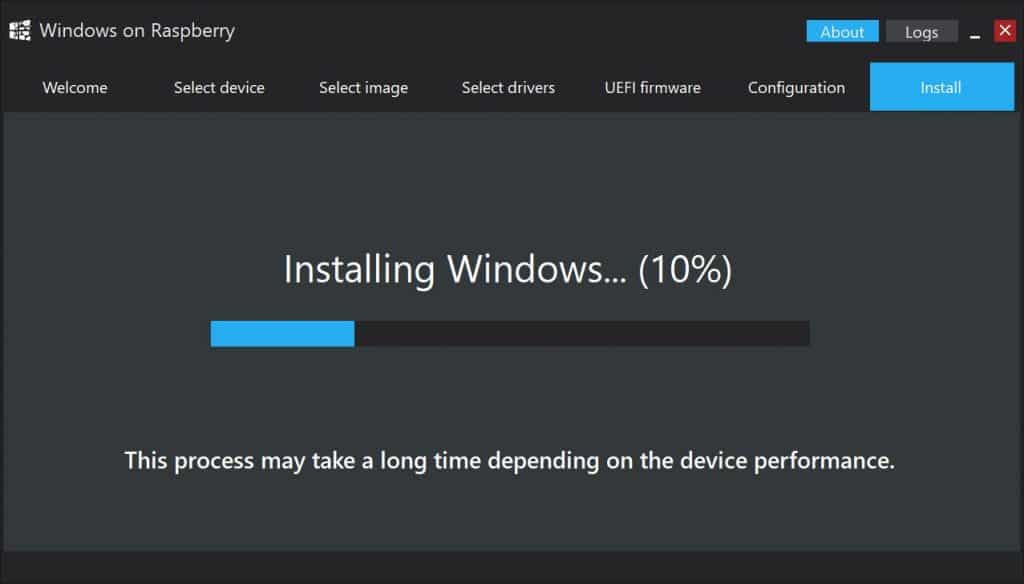
This step will still be longer than we are used to with Linux systems, but not that much.
On a SSD drive, it should be something like 15 minutes. On a SD card it can be really long, probably over an hour.
First boot
Once your drive is ready, you can plug it into your Raspberry Pi (or insert the SD card) and boot it up.
This step also is pretty long, as there is an installation process running in the background to configure everything for your specific device.
By the way, the second boot will be faster – it’s only the first boot that is a little long.
And that’s another step that is really faster with an SSD drive instead of an SD card.
As with any Windows 10 installation, there are a few things to configure in the first boot, like Cortana and all the privacy policies that Microsoft tries to disable for you:

Once done, you should get access to the Windows 10 desktop interface.
Nothing surprising here, but it’s nice to see it finally works in full version on a small Raspberry Pi.
Windows 10 overview
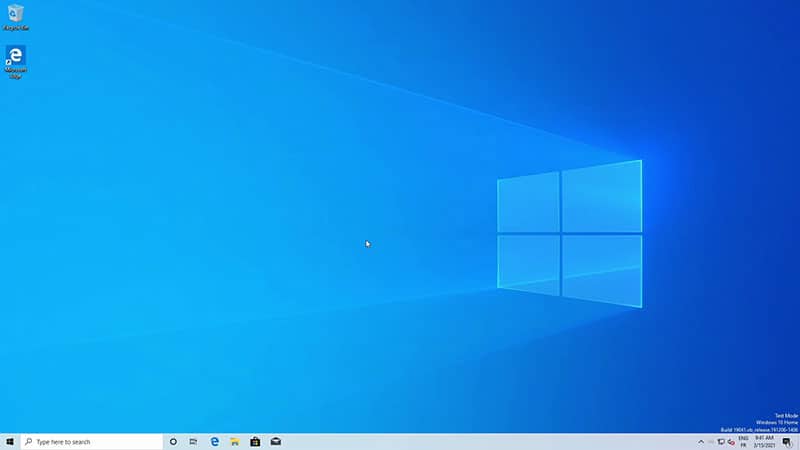
Yeah, Windows 10 is now running on our Raspberry Pi, but how does it actually work? Is it a good system for desktop usage?
Default apps
Overall, the system is pretty responsive.
You can browse in the settings or file explorer without any lag, and the default apps work pretty well.
Watch the video at the end of this tutorial to get a better idea of how it runs.
The default apps on my edition were basic ones (Accessories, Paint 3D, Office, etc.), but I was pretty impressed by the results.
It’s maybe not as responsive as my laptop, but it’s worth considering, given the price of the hardware.
Hardware support
After digging a bit into the system configuration, I found that not everything was working perfectly.
For example, there is no sound card detected (no audio output) and it doesn’t detect my second screen.
I didn’t spend time looking for drivers or workaround, so there may be some solutions out there.

Just don’t expect to work perfectly out-of-the-box.
As you have seen for the installation part, the Raspberry Pi is not supported by Microsoft, so this installation is more of an experiment than a perfect solution.
Installing new apps
After the configuration issues, I also tried installing other random apps.
I picked some I often use on my computer, like VLC, Audacity and Raspberry Pi Imager.
I didn’t have any issue installing them, and they worked really well:
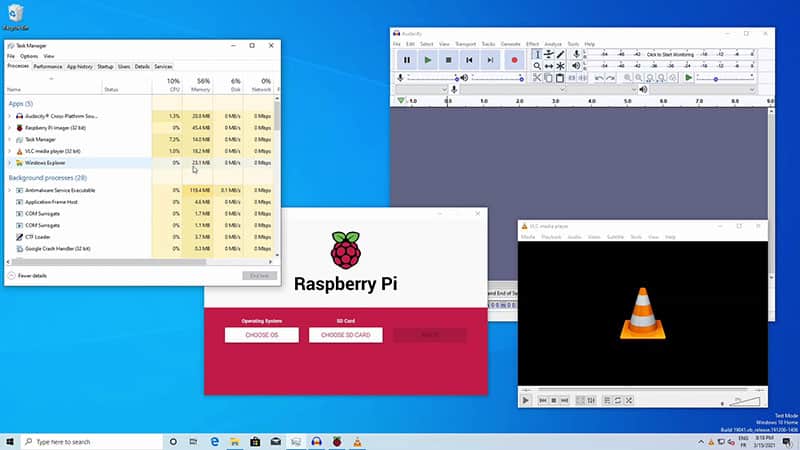
This is the most exciting part with an official Windows 10 running on Raspberry Pi in the future.
With around 80% of desktop users running Windows on their computers, we can expect them to easily switch to Raspberry Pi if they can stay on the same operating system.
Install it on a Raspberry Pi 400, and they won’t even see the difference with a standard computer :).
Yeah, we are pretty far from the original vision and the license system will probably be an issue.
Performance limits
A little warning however about the performances of this operating system.
As there is no optimization for the Raspberry Pi, you will reach the limits pretty quickly with some usage.
For example, watching YouTube on Google Chrome will be complicated. And if you want 1080p in full screen it’s almost impossible. Check the video below to see the results I got.
The memory and CPU were close to 100%, and I had nothing else running at the same time.
Video: Install Windows 10 on Raspberry Pi
To conclude, Windows 10 on Raspberry Pi is now pretty to do, but the process is very long and everything isn’t fully supported yet.
It can be a decent solution for basic usage if you absolutely need to run Windows, but if you have the choice a distribution like Twister OS would probably be a better alternative.
If you are looking for exclusive tutorials, I post a new course each month, available for premium members only. Join the community to get access to all of them right now!
You may also like:
- Master Raspberry Pi in 30 days with this
- 57 Raspberry Pi commands you need to know
- Remote access your Pi from anywhere (best apps)
- Auto start any program when the Raspberry Pi boots up
- Create an image of your SD card (safety first!)
Do you need help to get started?
By the way, maybe you are new on Raspberry Pi and were looking for an easy way to stay on Windows because you are used to it on the PC. I’m sorry, but as you have seen, it’s not yet ready.
The Raspberry Pi world might be overwhelming for beginners, you may be lost among the different models, the operating systems and the thing you can do with it or not.
That’s why I have put together a mini-course to help you for the first steps.
By watching a few videos and following my tips, you can jumpstart your journey with a Raspberry Pi, avoid all the obstacles and start having fun with this exciting device.
Sounds interesting? Learn more on this page.
I’m the lead author and owner of RaspberryTips.com.
My goal is to help you with your Raspberry Pi problems using detailed guides and tutorials.
In real life, I’m a Linux system administrator with web developer experience.
- Home
- Blog
-
Step-by-Step Procedure to Install Windows 10 on A Raspberry Pi 4
/
/
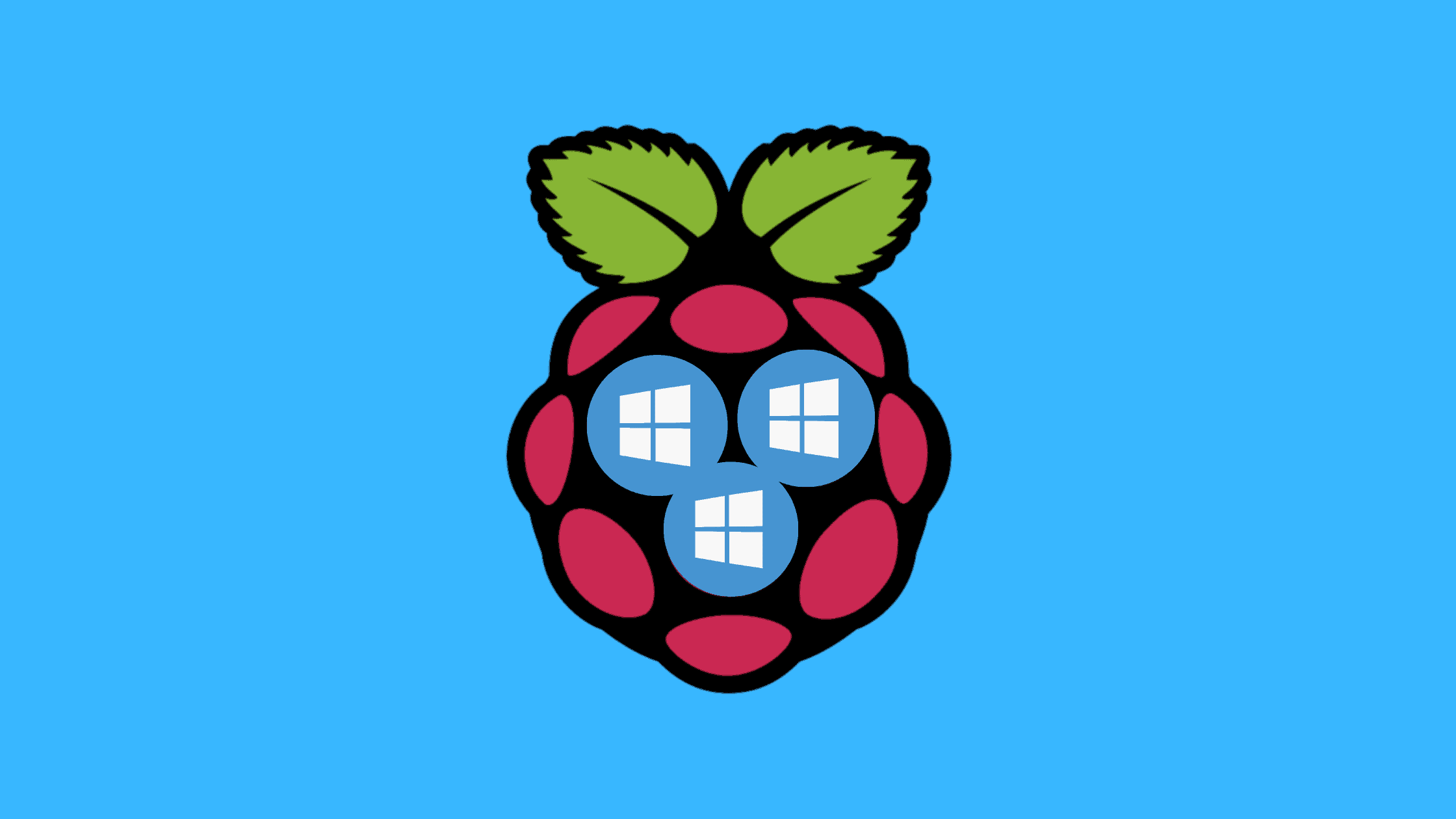
There are a number of reasons why you might need to run Windows 10 on Raspberry Pi. One reason is for educational purposes, as running Windows 10 on the device can provide a great platform to teach coding skills and even create projects with the Windows IoT Core technology. Additionally, running Windows 10 on Raspberry Pi can be useful for small businesses or hobbyists who need a small and affordable device for running Windows applications or controlling hardware connected to the Pi. Finally, running Windows 10 on Raspberry Pi can be great for home automation projects, as it provides a platform for connecting to internet-enabled devices like smart light bulbs and thermostats. All in all, running Windows 10 on Raspberry Pi is a great way to get started with a powerful and affordable device. Let’s see the step-by-step procedure to install Windows 10 on a Raspberry Pi.
A Short Introduction To WoR Project
Windows on Raspberry Pi is a project that provides an easy-to-use way to get Microsoft Windows 10 running on the popular single board computer, Raspberry Pi. This project has been around for several years and has gone through various iterations, but it continues to be actively developed by a dedicated team of developers who are passionate about providing users with the latest and greatest Windows experience on the Raspberry Pi.
The main goal of this project is to give users a full-featured version of Windows 10 that runs well on the Raspberry Pi. This includes providing drivers for peripherals such as cameras, keyboards, and mice, as well as support for industry-standard networking protocols such as Wi-Fi and Bluetooth. By running Windows on the Raspberry Pi, users are also able to take advantage of a wide range of software that has been written specifically for the Windows operating system.
The project provides an easy-to-use installer that walks users through setting up and installing Windows 10 on their Raspberry Pi in just a few simple steps. The installation process is designed to be as streamlined and automated as possible, taking the guesswork out of setting up a Windows environment on the Raspberry Pi.
Prerequisites to Install Windows 10 on A Raspberry Pi
Let’s see what hardware and software are required to install Windows 10 on a Raspberry Pi:
Hardware:
-
Raspberry Pi Board: Well, you can use any Raspberry Pi module 4, or 400. Preferably, Raspberry Pi 3 and 4 with 4 GB RAM.
-
Micro SD Card with Card Reader: This is to write Windows 10 images.
-
USB Drive: This is to install windows operating systems. It is optional. This is required only if you boot your Pi from USB storage.
-
IO Peripheral: Keyboard, Mouse, HDMI Cable, Ethernet Cable, and USB Cable, depending on your requirements.
-
PC or Mac with an Internet connection: This is required to download the Windows 10 ISO file with Imager and write the Windows 10 to the SD Card or USB Storage Drive.
Software:
-
Windows on Raspberry imager: A free utility released by WoR Project for flashing content to SD cards and USB drives on your Raspberry Pi.
-
Internet: An Internet connection is a must to have to download the imager and create windows 10 ISO image.
How to Install Windows 10 on A Raspberry Pi 4?
Once you get all the things listed in the previous section ( Required Hardware & Software) you are good to start the installation procedure. Let’s see how to install Windows 10 on a Raspberry Pi in just a few simple steps.
Installing Windows operating systems on Raspberry Pi is not straight forward as installing other Linux operating systems. You will not get a bootable Windows image to flash on the SD card or USB drive. You should prepare a Windows ISO image on your own using the UUP Dump script and flash the created Windows image to an SD card or USB drive using the ‘Windows on Raspberry imager‘ tool from the WoR project. Don’t worry. We will show you everything that you need to install Windows 10 on a Raspberry Pi in this post.
Step 1. Download the UUP Dump Script to Create Windows 10 Image
We encourage you to take a look at the Getting Windows Images guide before you proceed. This guide will help you to choose the right version of the operating system. We are not going with the ESD image as it supports the WoR-PE package.
Since there is no official Windows ISO image is available for download. You should download the UUP dump scripts.
1. Go to https://uupdump.net
2. You will be greeted with four versions of Windows. Dev Channel, Windows 11, Windows Server, and Windows 10. As soon as you click on Windows 10, a dropdown will appear. Select the latest available build. We have 22H2 as the latest build available at the time of publishing this post.3. Select the Release Type you want to download. We have chosen ‘Feature update to Windows 10‘ that comes with the updated build for regular usage.4. Each Windows image is made available in multiple Architectures. 1. x64, 2. x86, 3. Arm64, and 4. Amd64. Click on the Arm64 as your Raspberry Pi’s processor is made of Arm architecture.5. In the next Window, choose Language, then Click Next.6. In the next step, choose Windows Edition. You can choose Home or Pro or both.7. In the Next Window. Choose the Download and Convert to ISO option. And, under the conversion options, select Include updates as shown in the below diagram.8. At last, click on the Create Download Package button. The package will start downloading as soon you click on it.
Step 2. Create a Windows ISO image running the UUP Dump script
The script will be downloaded as a zip archive file. You should extract the content of the zip file to a different directory. Imp Note: The directory name shouldn’t have any space char.
We have unzipped the file into F:\WindowsForRPI directory. You are free to choose your own path.
In the extracted files, you will see scripts created to run on Windows, mac and Linux since we are using Windows PC in this demo. We ran Windows script: uup_download_windows.cmd.
As soon as you run the file as ‘Run As Administrator,’ the script will start downloading the required files and creating the Windows ISO image to write on the SD card or USB drive.
Note: this is a very time-consuming process. It may take up to 1 hr, depending on your internet and computer processing speed. You should wait until the process gets completed.
Once you are done with the process, you will see the “Press 0 to Exit” message. This indicates that the process is successfully completed. There is an ISO image file in the directory of the script. Imp Note: we would suggest disabling the Antivirus program before you run the UUP Dump script. We ended up in failure in our initial attempts. We got success only upon disabling the Antivirus protection.
For more details, you can join the WoR Discord channel.
Step 3. Download and Run the Windows on Raspberry imager tool
Windows on Raspberry imager is a free tool that you need to download. We downloaded v2.3.1, which is the latest available, while we published this post.
Move the zip file to a different location and unzip it. You will see the ‘WoR.exe’ file upon unzipping. Run the ‘WoR.exe’ file to run the Windows on the Raspberry imager tool.Note: There is a separate imager is made available for download for PE-based installation. We are not covering PE-based installation in this post. If you want to know more about the PE-based installer, please visit this link.
Step 4. Select the Storage device & Device type
Immediately upon hitting the Next button, you will be asked to select the Storage drive, which is your SD card or USB drive, and the Device type, which is your Raspberry Pi device module. Select both the storage and devise type, then click Next.
Note: If you are using a USB drive, then you should use the GPT partition scheme with the latest boot loader.
Step 5. Select the Windows ISO image
Browse the Windows ISO file created in Step 2. click Next.
Step 6. Select the Driver
Select the first option, which is “Use the latest package option available on the server.” Click Next.
Step 7. Select the UDFI Firmware
Select the first option, which is “Use the latest firmware available on the server.” Click Next.
Step 8. Configure Install and Boot options
There are a few Install and Boot options available to configure as per your needs. We are not going to tweak anything for now. It is not required either. Click Next with the same default configurations.
Step 9. Take a look at the Installation Overview
On this screen, you will see the overview of the installation. If you feel you want to change the settings, just go back and tweak the change you want to go with. If not, everything looks perfect. Click Install.
Step 10. Complete the Installation process
The process will start with formatting the drive and creating partitions before installing the Windows operating system. Depending on your system resources and storage device R/W speed, this process may take several minutes. Let the process complete. Click Finish to complete the installation process.
Step 11. Boot the Raspberry Pi inserting the flashed SD card or USB drive
Connect all the peripheral devices like Mouse, Keyboard, power adopter, and monitor to your Raspberry Pi. Insert the Windows image flashed micro SD card or plugin the USB drive fire up the Raspberry Pi.
Step 12. Set up the Windows on Raspberry Pi
Since you are booting Windows on the Raspberry Pi for the first time, it asks to set up your Windows as in the case of your Windows PC. Set up the Language, Keyboard layout, time zone, account, password, security questions, network, and everything that it asks to set up.
Upon finishing the Windows set up process. Your windows 10 desktop is ready to use.
That’s all. This is how you should install Windows 10 on a Raspberry Pi.
Running Windows 10 on Raspberry Pi 4
Once the installation is complete, users can start exploring the Windows 10 operating system and all its features from their Raspberry Pi. With the help of this project, users are able to experience the full power of Windows 10 on the popular single board computer, Raspberry Pi. Windows on Raspberry Pi provides an easy and affordable way to get the most out of your Raspberry Pi with the power of Windows 10. So why wait? Get started today!
We hope this post would help you learn how to install Windows 10 on a Raspberry Pi. Thanks for reading this tutorial post. Visit our social media page on Facebook, LinkedIn, Twitter, Telegram, Tumblr,Medium & Instagram,and subscribe to receive updates like this.
You may also like these articles:
Arun KL
Arun KL is a cybersecurity professional with 15+ years of experience in IT infrastructure, cloud security, vulnerability management, Penetration Testing, security operations, and incident response. He is adept at designing and implementing robust security solutions to safeguard systems and data. Arun holds multiple industry certifications including CCNA, CCNA Security, RHCE, CEH, and AWS Security.

